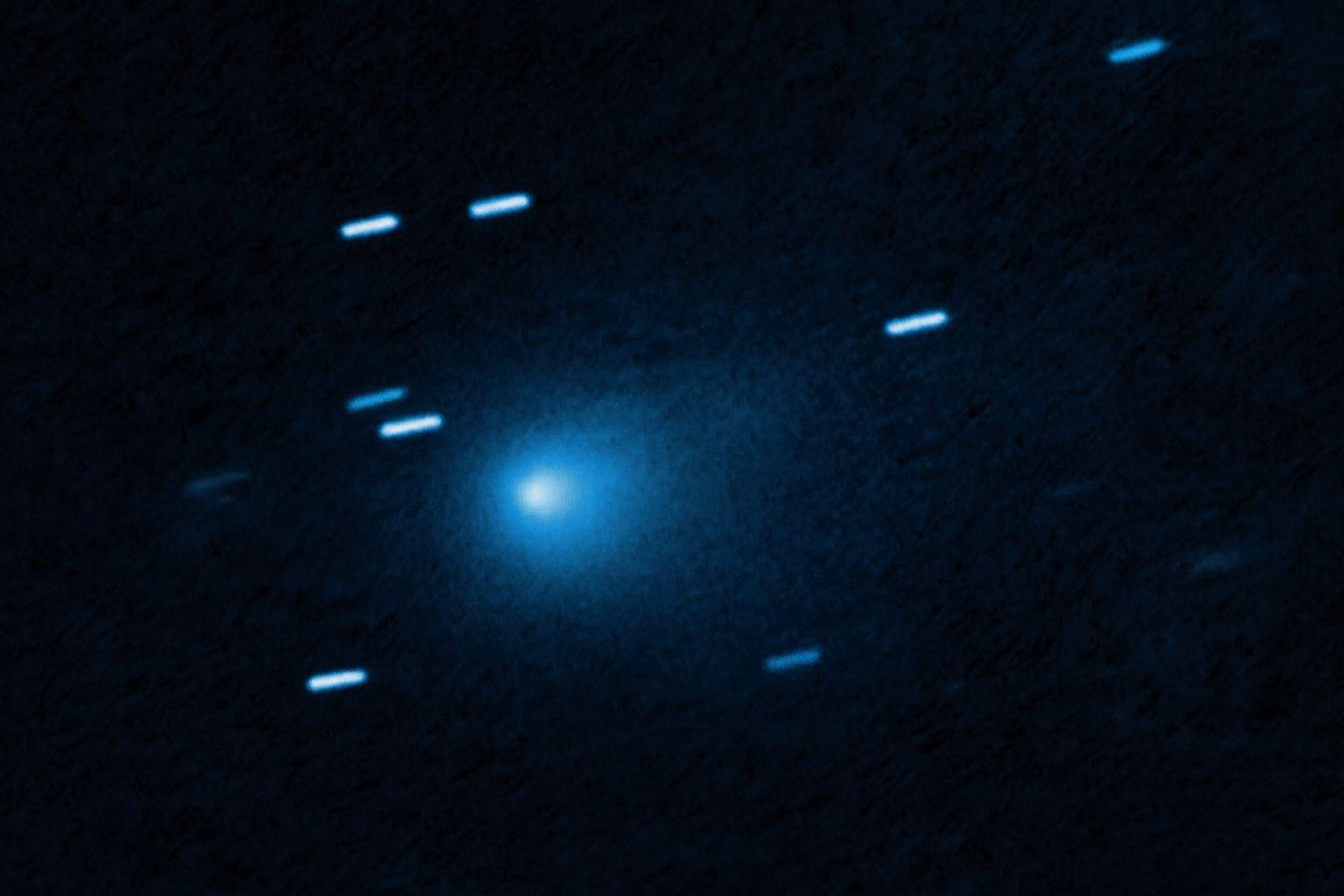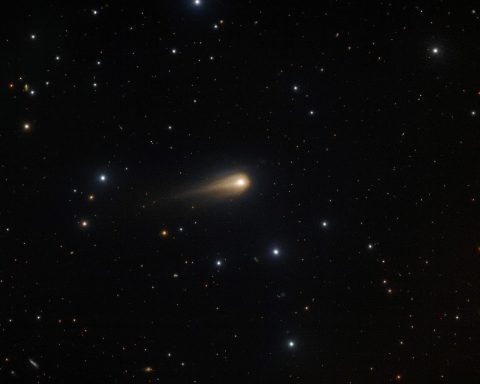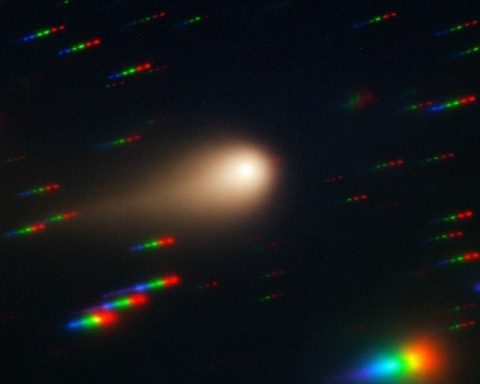- 3I/ATLAS was first spotted on July 1, 2025 by the ATLAS telescope in Río Hurtado, Chile, and officially designated 3I/2025 A1 (ATLAS), the third confirmed interstellar object after 1I/‘Oumuamua (2017) and 2I/Borisov (2019).
- It is traveling through the inner solar system at about 60–61 kilometers per second relative to the Sun on a hyperbolic trajectory, with perihelion near the orbit of Mars in late October 2025 (about 1.4 AU).
- Its closest approach to Earth will be roughly 1.6–1.8 AU (240–270 million kilometers), and it will be behind the Sun from Earth’s perspective at that time, posing no threat.
- The Hubble Space Telescope captured images on July 21, 2025 showing a teardrop-shaped cocoon of dust around a solid nucleus with a faint tail, indicating active cometary outgassing.
- Hubble constrains the nucleus to at most about 5.6 km in diameter, with estimates placing it around 1–2 km and possibly as small as 0.3–0.32 km.
- 3I/ATLAS is clearly a comet with a visible coma and tail, making it more similar to 2I/Borisov than to 1I/‘Oumuamua, which lacked a coma.
- Kinematic analyses suggest a Milky Way thick-disk origin, implying an age over 8 billion years, with alternative estimates spanning 11 to 3 billion years.
- A coordinated observational campaign gathered over 100 observations in the first week across Hubble, JWST, TESS, Swift, and Keck to measure size, rotation, and composition.
- Spectroscopy will reveal its chemical makeup, helping determine whether its building blocks are similar to those of our solar system, with early dust-loss rates already consistent with solar-system comets.
- The Rubin Observatory is expected to find many more interstellar objects in coming years, and ESA’s Comet Interceptor (launching in 2029) aims to intercept a pristine comet or possibly an interstellar visitor as a fast-response mission.
Hubble Space Telescope image of interstellar comet 3I/ATLAS on July 21, 2025. The comet appears as a teardrop-shaped, bluish cocoon of dust (coma) around its solid icy nucleus, with a faint tail. Streaks in the image are background stars blurred by Hubble tracking the fast-moving comet [1] [2].
Discovery and Naming of 3I/ATLAS
The comet 3I/ATLAS – officially designated 3I/2025 A1 (ATLAS) – was first spotted on July 1, 2025, by the Asteroid Terrestrial-Impact Last Alert System (ATLAS) telescope in Río Hurtado, Chile [3] [4]. ATLAS is a NASA-funded survey designed to catch incoming asteroids, and on that night ATLAS team member Larry Denneau noticed a new moving dot beyond Jupiter’s orbit [5]. At first it seemed like a routine find, but follow-up observations quickly revealed the object was on a highly unusual path. Within a day, astronomers confirmed the object was not bound to our Sun, meaning it came from interstellar space [6] [7]. It is only the third interstellar object ever observed, after 1I/‘Oumuamua in 2017 and 2I/Borisov in 2019 [8] [9].
Once its extrasolar nature was recognized, the object received a formal designation from the International Astronomical Union. The name “3I/ATLAS” reflects its status and discoverer: the “3” marks it as the third interstellar object (I stands for “interstellar”), and ATLAS credits the telescope network that found it [10] [11]. (Before confirmation, it had a provisional code A11pI3Z [12].) The interstellar classification is based on the comet’s extreme orbit: it is on a one-time hyperbolic trajectory that is not closed around the Sun, so tracing its path backward clearly shows it came from outside our solar system [13]. “We don’t know exactly where it came from, but it definitely came from outside the solar system,” explains Dr. Laura Driessen, a radio astronomer at the University of Sydney [14].
Speed, Trajectory, and Interstellar Journey
Traveling at an extraordinary velocity, 3I/ATLAS is hurtling through the inner solar system at roughly 60–61 kilometers per second (about 137,000 miles per hour) relative to the Sun [15] [16]. Such blistering speed is far higher than typical solar system comets and ensures the object will escape the Sun’s gravity rather than settle into an orbit [17]. “That’s far faster than any solar system object should be able to move,” notes amateur astronomer Sam Deen, because anything moving so quickly can’t be captured by the Sun – instead, 3I/ATLAS is carving out a hyperbolic path through our system [18].
NASA diagram of comet 3I/ATLAS’s trajectory through the solar system. The interstellar comet entered from above the planetary plane, passed inside Jupiter’s orbit, and will reach perihelion (closest point to the Sun) near the orbit of Mars in late October 2025 [19] [20].
After entering the solar system from the direction of the constellation Sagittarius [21], 3I/ATLAS sped inbound toward the Sun. It passed the orbit of Jupiter around mid-2025 [22] and is heading for a swing around the inner solar system. It will make its closest approach to the Sun (perihelion) around late October 2025, coming just inside the orbit of Mars (about 1.4 AU from the Sun, or 210 million km) [23] [24]. After that, it will slingshot back out toward interstellar space, never to return. Notably, 3I/ATLAS’s path will take it between the orbits of Mars and Earth – essentially cruising through the inner solar system – before it loops around the Sun and heads back out into the cosmos [25]. Because it’s on a hyperbolic escape trajectory and moving so fast, “it will just fly out the other side of the solar system,” explains Dr. Rebecca Allen of Swinburne University [26].
Although it comes relatively far inward, 3I/ATLAS poses no danger to Earth. Its closest pass by Earth will still be around 1.6–1.8 astronomical units away – roughly 240–270 million kilometers, well beyond even the orbit of Mars [27] [28]. “There is no threat to Earth: during its brief sojourn 3I/ATLAS is projected to come no nearer than about 240 million kilometers from our planet,” Scientific American reported [29]. In fact, that distance is over 1.5 times the gap between Earth and the Sun, so stargazers need not worry about any close encounter [30]. The comet will be behind the Sun from Earth’s perspective during its closest approaches, making it hard to observe in late fall, but it should reappear from the Sun’s glare by early December 2025 as it recedes outward [31] [32].
Its interstellar origin means 3I/ATLAS has likely been traveling for millions or billions of years through the galaxy before this fly-by [33]. Astronomers can’t pinpoint the exact star system it came from – after eons adrift, any original home star is impossible to trace with certainty amid the Milky Way’s myriad stars [34]. However, researchers are already modeling possibilities. One team noted the comet’s high incoming speed and trajectory suggest it may hail from the Milky Way’s “thick disk” – a population of ancient stars that orbit above and below the galaxy’s main plane [35]. A thick-disk origin would imply 3I/ATLAS is extremely old, perhaps over 8 billion years old. “It’s from a star that’s potentially not even there anymore,” says Dr. Michele Bannister, hinting that the comet could predate our own Sun by billions of years [36]. Another analysis based on its motion estimates an age between 11 billion and 3 billion years (the large range reflecting uncertainties) [37]. In any case, 3I/ATLAS may be one of the oldest comets ever observed, a pristine relic formed long before our solar system [38].
Size, Shape, and Physical Composition
What does this interstellar visitor look like? Initially, when 3I/ATLAS was just a faint dot, its exact size was hard to pin down. Early brightness measurements allowed for a wide range of possible sizes – it “could be anywhere from five to 50 kilometers in diameter,” Larry Denneau said shortly after discovery [39]. A 50 km object would be enormous for a comet, but most experts suspected it was much smaller [40]. As more data rolled in, those estimates were revised downward. The Hubble Space Telescope captured images of 3I/ATLAS on July 21, 2025, and by analyzing the brightness of the comet’s compact head (after subtracting the surrounding glow of dust) researchers set an upper limit on the nucleus’s size [41] [42]. Hubble’s observations indicate the solid nucleus is at most about 5.6 km in diameter, and it could be as small as roughly 300–320 meters across [43] [44]. In other words, the core of 3I/ATLAS is likely on the order of a kilometer or two wide, similar in scale to many known comets. “It’s probably somewhere in the range of one or two kilometers,” says Dr. John Noonan of Auburn University, comparing it to our first two interstellar visitors [45]. (For context, 1I/‘Oumuamua was only about 100–400 meters long, while 2I/Borisov’s nucleus was roughly 1 km wide [46].)
Because 3I/ATLAS is active – emitting gas and dust like a normal comet – its true shape is difficult to discern. The object appears as a fuzzy “coma” (a cloud of material) surrounding an unresolved core in telescope images [47]. There’s no indication so far of an exotic shape; it’s likely an irregularly shaped icy body, as is typical for comets. Hubble did reveal a teardrop-shaped cocoon of dust being shed off the nucleus and a faint dust tail trailing behind, both signatures of cometary activity [48] [49]. In fact, 3I/ATLAS looked a bit like a “fuzzy snowball” in the Hubble images, according to Dr. Rebecca Allen [50]. The comet’s hazy appearance comes from sunlight warming its surface and causing ices to sublimate (turn directly to vapor), which releases dust and gas to form the glowing coma and tail [51] [52].
Spectral measurements in the coming months will allow scientists to analyze the chemical makeup of that ejected material. As 3I/ATLAS nears the Sun, its coma will grow and reveal the elements and molecules it contains [53]. “We can use a tool called spectroscopy, and use light to understand exactly what that material is,” Dr. Allen explains. “Does this comet represent a solar system that had very similar conditions to our own, or is it something completely different?” [54] The answer could tell us whether the building blocks of planets (like water, carbon compounds, etc.) are common across other star systems or not. Early signs already point to some similarities: for example, the dust-loss rate Hubble measured from 3I/ATLAS’s coma is consistent with comets observed at similar distances in our own solar system [55] [56]. As one NASA scientist put it, the key question is, “Does the comet look like objects from our own solar system?” Either outcome is exciting. “If it has the same composition as a normal comet, it means that other solar systems may be built similarly to ours. If it’s completely different, then we might wonder why that is,” Denneau observed [57].
Comparison with ‘Oumuamua and Borisov (Previous Interstellar Objects)
3I/ATLAS follows in the footsteps of its two famous predecessors, and astronomers are eager to see how it compares. Here’s a quick recap of the only three interstellar objects ever observed:
- 1I/‘Oumuamua (2017): The first interstellar visitor detected was a small, mysterious object discovered in October 2017. ‘Oumuamua was notable for having no visible coma (so it was initially thought asteroid-like) and an odd elongated shape inferred from its light fluctuations [58]. It was only about 100–400 meters in size, yet showed a mysterious non-gravitational acceleration – a slight change in course not explained by gravity alone [59]. Many scientists suspect this was due to comet-like outgassing of volatile ices (even if no coma was seen), or perhaps pressure from sunlight, but the exact cause is still debated [60]. ‘Oumuamua’s bizarre properties led to much speculation, including a now-discredited idea that it might be an alien probe [61]. Unfortunately, it was discovered on its way out of the solar system, so telescopes had little time to observe it in detail [62].
- 2I/Borisov (2019): The second interstellar object, found in 2019 by amateur astronomer Gennadiy Borisov, turned out to be a much more conventional comet. 2I/Borisov had a pronounced coma and tail, indicating active sublimation of ices, and its composition (e.g. presence of water vapor and carbon monoxide) was broadly similar to comets from our own solar system [63]. With a nucleus roughly ~1 km across, Borisov was essentially “a run-of-the-mill comet, albeit an extrasolar one,” as one report noted [64]. Because it looked and behaved like normal comets, Borisov didn’t provoke the same outlandish alien theories – instead, it confirmed that other star systems can produce cometary bodies like those we know [65].
- 3I/ATLAS (2025): Our new visitor 3I/ATLAS appears to be much more like Borisov than ‘Oumuamua in nature. It is actively outgassing, with gas and dust forming a coma, so astronomers classify it confidently as a comet [66] [67]. Its exact size (likely 1–5 km) may be larger than Borisov’s, but certainly not extraordinarily large (initial fears of a 20+ km giant have been dispelled) [68] [69]. Importantly, 3I/ATLAS was discovered inbound and relatively early, giving scientists ample time to study it with powerful telescopes as it approaches the Sun. As Dr. Mario Jurić of the University of Washington remarked, this comet will be a “tiebreaker of sorts” – helping us determine whether ‘Oumuamua was the oddball and most interstellar objects are comet-like, or if the galaxy sends us more surprises [70]. Early indications, with 3I/ATLAS showing ordinary comet behavior, suggest that ‘Oumuamua may indeed have been an outlier [71]. “Since 3I/ATLAS appears to be a comet, like 2I/Borisov, we can determine that comet-like [behavior] is more common,” wrote astronomers Aster Taylor and Darryl Seligman [72] [73]. With a sample size of three now, scientists can start to treat these interstellar visitors as a population, rather than one-off curiosities.
Unusual Features and Anomalies (or the Lack Thereof)
So far, 3I/ATLAS has not exhibited any bizarre anomalies – and that in itself is noteworthy. Unlike ‘Oumuamua’s unexplained acceleration and strange shape, 3I/ATLAS is behaving exactly like a typical comet (just one from another star). Its trajectory is perfectly accounted for by gravity, and any slight perturbations should be due to standard cometary outgassing as it warms, not any mysterious forces. Visually, it’s a fuzzy point with a growing tail, not a bare rock tumbling end over end as ‘Oumuamua appeared to be [74]. “There’s no evidence to point towards [3I/ATLAS] being anything other than a really fun space rock that came from outside the solar system,” Dr. Driessen says – “which, to be honest, is cool enough.” [75]
That hasn’t stopped a few speculations from cropping up. In fact, a small group of researchers led by Harvard astronomer Avi Loeb put out a provocative paper in July 2025 asking, “Is the interstellar object 3I/ATLAS alien technology?” [76]. They hypothesized, as a thought experiment, that 3I/ATLAS could conceivably be some form of extraterrestrial probe in disguise [77] [78]. The paper pointed to some so-called “anomalous characteristics” (such as the comet’s trajectory offering close approaches to planets like Jupiter and Mars) and mused about an advanced civilization using the comet to spy on the solar system or even deploy devices on those planets [79] [80]. In a blog post, Loeb speculated that if 3I/ATLAS were a crafted object, its covert path – including being hidden behind the Sun from Earth’s view at closest approach – could align with the “dark forest” hypothesis (the idea that aliens stay quiet to avoid detection) [81] [82]. He even noted that based on its speed, 3I/ATLAS would have entered the outer solar system about 8,000 years ago, “roughly when human-made technologies became advanced enough to start documenting history,” hinting (tongue-in-cheek) at a possible timing if it were sent here [83].
Extraordinary claims make catchy headlines – and indeed some media and social networks ran wild with the “alien probe” angle in late July. A New York Post article suggested the comet “could” be an alien craft, which soon morphed into alarmist social media posts claiming a “hostile alien ship” was headed for Earth and would arrive by November [84] [85]. These rumors of an incoming alien invasion went so viral that fact-checkers at Snopes stepped in to debunk them. The claim that scientists were “certain” 3I/ATLAS was an alien ship was rated false: “Scientists did not warn that [it] was ‘most likely’ or ‘certainly’ an alien ship… The overwhelming scientific consensus was that the object was likely an interstellar comet,” Snopes reported [86]. In reality, even Loeb and his co-authors did not believe their hypothesis was the likeliest scenario – they explicitly wrote in their conclusion that “by far, the most likely outcome will be that 3I/ATLAS is a completely natural interstellar object, probably a comet.” [87]. The authors described their paper as a fun “pedagogical exercise” in considering a low-probability scenario, not a claim that aliens are actually incoming [88] [89]. Most astronomers found the alien probe idea unconvincing (a Live Science piece quoted experts calling it “nonsense” and even “insulting” [90] [91]) – essentially a rerun of the ‘Oumuamua debate. As Dr. Allen quipped regarding 3I/ATLAS, speculation about an alien incursion makes for good sci-fi, but “it wasn’t [alien]” in the case of ‘Oumuamua and there’s no evidence this comet is anything but natural [92].
Scientific Significance and Future Plans
Beyond the social media buzz, scientists are genuinely thrilled about 3I/ATLAS – not because they suspect aliens, but because this comet offers a precious scientific opportunity. “We’ve never had an object like this to study before,” said Dr. Allen [93]. Interstellar objects are like messengers from other star systems, carrying material formed around distant suns. Every planet, asteroid, and comet native to our solar system shares a common origin around our Sun, but 3I/ATLAS is a true outsider, a chunk of a planetesimal from an entirely different solar neighborhood [94]. “What makes interstellar objects like 3I/ATLAS so extraordinary is their absolutely foreign nature,” the European Space Agency noted. “They are remnants of other planetary systems, carrying with them clues about the formation of worlds far beyond our own.” [95] Studying the composition and behavior of 3I/ATLAS will help astronomers test whether other solar systems produce the same kinds of materials as ours, or if this visitor is chemically unique. As Dr. Denneau pointed out, either result is illuminating – a familiar composition would suggest planetary systems across the galaxy have common building blocks, whereas an exotic makeup would raise new questions about planetary formation elsewhere [96].
Researchers worldwide have mobilized to observe 3I/ATLAS with as many instruments as possible during its sojourn. Within days of the July discovery, telescopes from Hawaii to Australia were trained on the comet [97]. Over 100 observations were reported in the first week alone, which confirmed the presence of a coma and tail [98]. Notably, some scientists had anticipated the discovery of an interstellar comet and reserved time on major observatories in advance. A team led by Stefanie Milam at NASA’s Goddard Space Flight Center, for example, had an observing program ready on the James Webb Space Telescope (JWST) to quickly target any new interstellar object [99] [100]. (In a humorous anecdote, they initially struggled to reach their program lead, who was off hiking in a remote area when 3I/ATLAS was found – but once contacted, JWST observations were promptly set into motion [101].) Along with JWST’s infrared eyes, NASA has marshaled its “fleet” of other space telescopes: Hubble (which has already provided a close-up image and size estimate [102]), the Transiting Exoplanet Survey Satellite (TESS), the Swift Observatory, and partnerships with ground-based observatories like Keck are all being used to monitor 3I/ATLAS [103] [104]. This coordinated campaign will cover a range of wavelengths, helping to refine the comet’s size, rotation rate, and chemical composition over time [105] [106].
Space agencies are also looking ahead to the possibility of future interstellar visitors. While 3I/ATLAS arrived with little warning (and is already too fast for any spacecraft to chase), the discovery comes at an apt time. A next-generation facility, the Vera C. Rubin Observatory in Chile, is just coming online and is expected to find many more interstellar objects in the coming years [107] [108]. Rubin’s frequent all-sky survey could catch these cosmic wanderers earlier and even flag any that might pass relatively nearer to Earth. If a future interstellar object were found on a trajectory that brings it close enough, scientists dream of mounting a mission to intercept or sample it. In fact, the European Space Agency is already planning a mission called Comet Interceptor (launching in 2029) which will wait in space at the Sun-Earth L2 point, ready to redirect to a target comet [109]. The baseline goal is to intercept a pristine Oort Cloud comet from the fringes of our solar system, but ESA notes that “unlikely but highly appealing,” a suitable interstellar object could be an alternate target [110]. Even if 3I/ATLAS itself is not reachable, this concept is a pathfinder for future fast-response missions that might one day chase down an interstellar interloper [111]. The scientific payoff would be immense: actually touching or collecting material from an alien solar system, rather than just observing from afar.
Cultural Impact and Public Fascination
The saga of 3I/ATLAS highlights not only scientific progress but also the public’s captivation with cosmic mysteries. News of the comet’s discovery and interstellar identity made headlines around the world in mid-2025, with major outlets like The Guardian explaining why this “mysterious comet” has scientists so excited [112]. In a time of renewed interest in space (and frequent science-fiction speculation), the idea of a visitor from another star resonated widely. Social media lit up with discussion – some of it factual wonderment at the scale of the galaxy, some of it veering into UFO territory. The fact that 3I/ATLAS arrived on the heels of two very different interstellar objects (one that many dubbed a potential alien craft, and another that was utterly normal) set the stage for a kind of natural experiment in public imagination. Would this third one be “the weird one” or “just a comet”? As it turned out, the comet’s relatively ordinary behavior has lent more support to the scientific narrative than to wild speculation. Astronomers have actively engaged with the media to emphasize the scientific importance of studying such objects, rather than indulging in alien hype. “[3I/ATLAS] will be a tiebreaker of sorts,” said Dr. Jurić, framing it as a chance to learn whether our first bizarre interstellar visitor was unique [113]. Likewise, NASA and ESA have used the opportunity to educate: NASA’s website and social channels provided FAQ explainers clarifying that 3I/ATLAS is a comet and poses no threat [114] [115], and ESA highlighted how it underscores our connection to the wider galaxy [116].
Of course, the sensational alien probe narrative also became part of the cultural moment. Within weeks, countless YouTube videos, memes, and clickbait articles appeared, ranging from genuine curiosity (“Could it be a lightsail from another civilization?”) to tongue-in-cheek (“Don’t panic, but aliens might have sent a comet”). The quick debunking by scientists and fact-checkers demonstrated the importance of critical thinking and scientific communication. Harvard’s Avi Loeb — often at the center of these debates — himself stressed that the comet is probably natural despite raising the question of artificiality [117]. His intent, he said, was partly to remind colleagues that we should keep an open mind, but also to gather data that disproves the exotic hypothesis, thereby strengthening our understanding of natural phenomena [118]. In a sense, the episode became a teaching moment: scientists openly considered an extraordinary idea (however unlikely) and then confidently pointed to evidence (or lack thereof) to refute it, reinforcing that extraordinary claims require extraordinary evidence.
Finally, 3I/ATLAS has a broader cultural and philosophical significance. It’s a vivid reminder that our solar system is not isolated – objects are drifting among the stars, and occasionally one will pay us a visit. As the European Space Agency eloquently put it, these interstellar wanderers offer “a rare, tangible connection to the broader galaxy – to materials formed in environments entirely unlike our own” [119]. For the public, there is something profoundly awe-inspiring about a chunk of ice and rock that formed around a distant sun and has traveled perhaps billions of years to casually swing through our neighborhood. It underscores the scale of our galaxy and the possibility that other worlds out there have their own asteroids, comets – and maybe life. The discovery of 3I/ATLAS has thus sparked not only scientific inquiry but also a sense of wonder. As humanity tracks this alien comet (alien in the original sense of “from elsewhere”) on its journey, we are reminded that the universe is dynamic and interconnected. Who knows what else might be out there heading our way? Each interstellar visitor, whether exotic or familiar, has a story to tell – and we are eager to listen.
References: The Guardian [120] [121] [122]; ESA [123] [124] [125] [126]; NASA [127] [128] [129]; Scientific American [130] [131] [132]; Space.com / Live Science [133] [134]; Snopes [135] [136].
References
1. science.nasa.gov, 2. science.nasa.gov, 3. www.esa.int, 4. www.scientificamerican.com, 5. www.scientificamerican.com, 6. www.esa.int, 7. www.scientificamerican.com, 8. www.theguardian.com, 9. www.esa.int, 10. www.theguardian.com, 11. science.nasa.gov, 12. www.scientificamerican.com, 13. science.nasa.gov, 14. www.theguardian.com, 15. www.theguardian.com, 16. science.nasa.gov, 17. www.scientificamerican.com, 18. www.scientificamerican.com, 19. science.nasa.gov, 20. www.scientificamerican.com, 21. science.nasa.gov, 22. www.scientificamerican.com, 23. science.nasa.gov, 24. www.scientificamerican.com, 25. www.theguardian.com, 26. www.theguardian.com, 27. www.esa.int, 28. science.nasa.gov, 29. www.scientificamerican.com, 30. www.esa.int, 31. www.esa.int, 32. science.nasa.gov, 33. science.nasa.gov, 34. www.scientificamerican.com, 35. www.scientificamerican.com, 36. www.scientificamerican.com, 37. www.scientificamerican.com, 38. www.space.com, 39. www.scientificamerican.com, 40. www.scientificamerican.com, 41. science.nasa.gov, 42. science.nasa.gov, 43. www.theguardian.com, 44. science.nasa.gov, 45. www.scientificamerican.com, 46. www.scientificamerican.com, 47. www.theguardian.com, 48. science.nasa.gov, 49. science.nasa.gov, 50. www.theguardian.com, 51. www.theguardian.com, 52. www.esa.int, 53. www.theguardian.com, 54. www.theguardian.com, 55. science.nasa.gov, 56. science.nasa.gov, 57. www.scientificamerican.com, 58. www.scientificamerican.com, 59. www.space.com, 60. www.space.com, 61. www.scientificamerican.com, 62. www.space.com, 63. www.scientificamerican.com, 64. www.scientificamerican.com, 65. www.scientificamerican.com, 66. science.nasa.gov, 67. www.scientificamerican.com, 68. www.scientificamerican.com, 69. science.nasa.gov, 70. www.scientificamerican.com, 71. www.space.com, 72. www.space.com, 73. www.space.com, 74. www.scientificamerican.com, 75. www.theguardian.com, 76. www.snopes.com, 77. www.space.com, 78. www.space.com, 79. www.space.com, 80. www.space.com, 81. www.space.com, 82. www.space.com, 83. www.space.com, 84. www.snopes.com, 85. www.snopes.com, 86. www.snopes.com, 87. www.snopes.com, 88. www.snopes.com, 89. www.snopes.com, 90. www.space.com, 91. www.space.com, 92. www.theguardian.com, 93. www.theguardian.com, 94. www.esa.int, 95. www.esa.int, 96. www.scientificamerican.com, 97. www.esa.int, 98. www.scientificamerican.com, 99. www.scientificamerican.com, 100. www.scientificamerican.com, 101. www.scientificamerican.com, 102. science.nasa.gov, 103. science.nasa.gov, 104. science.nasa.gov, 105. science.nasa.gov, 106. science.nasa.gov, 107. www.scientificamerican.com, 108. www.scientificamerican.com, 109. www.esa.int, 110. www.esa.int, 111. www.esa.int, 112. www.theguardian.com, 113. www.scientificamerican.com, 114. science.nasa.gov, 115. www.snopes.com, 116. www.esa.int, 117. www.snopes.com, 118. www.snopes.com, 119. www.esa.int, 120. www.theguardian.com, 121. www.theguardian.com, 122. www.theguardian.com, 123. www.esa.int, 124. www.esa.int, 125. www.esa.int, 126. www.esa.int, 127. science.nasa.gov, 128. science.nasa.gov, 129. science.nasa.gov, 130. www.scientificamerican.com, 131. www.scientificamerican.com, 132. www.scientificamerican.com, 133. www.space.com, 134. www.space.com, 135. www.snopes.com, 136. www.snopes.com









